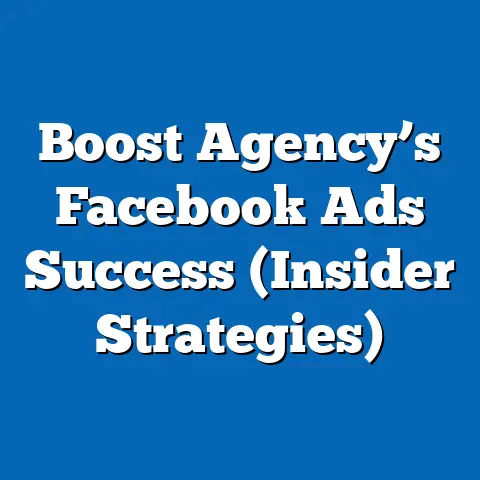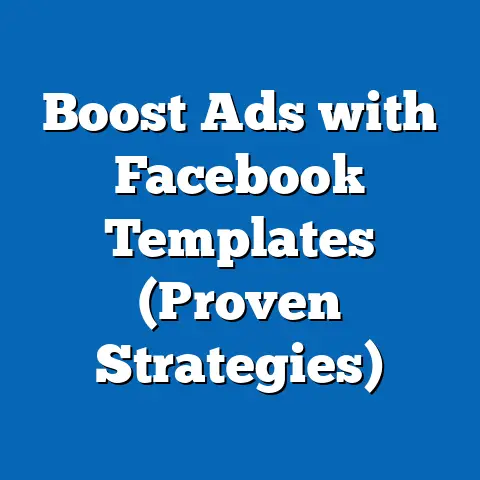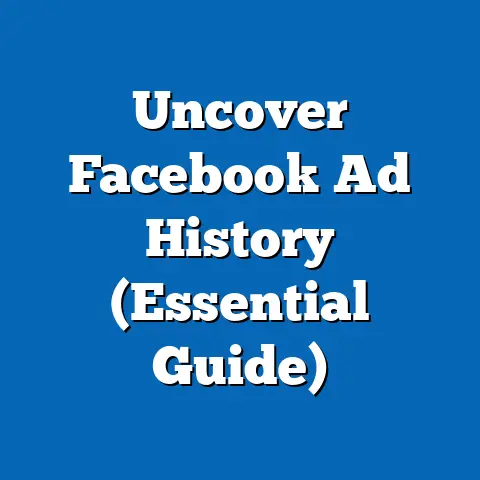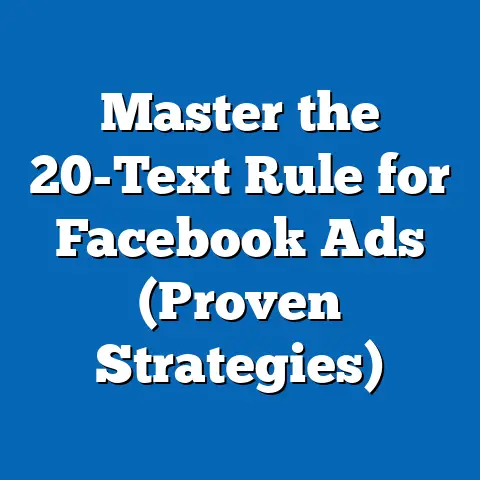Maximize Allbirds Facebook Ads Success (Proven Strategies)
I’ve seen countless brands stumble when diving into Facebook advertising. They often treat it like a simple game of throwing money at the platform and hoping for the best. The biggest mistake I observe is a lack of deep understanding of their target audience. This leads to generic, uninspired ads that simply don’t resonate. Imagine launching an ad campaign promoting your brand’s sustainable practices to an audience that primarily cares about the cheapest price point – it’s a recipe for wasted ad spend and missed opportunities. In fact, studies show that poorly targeted ads can have a click-through rate as low as 0.1%, compared to well-targeted ads that can achieve rates of 2% or higher.
For a brand like Allbirds, which has built its reputation on sustainability and eco-conscious consumerism, understanding their audience is absolutely paramount. They can’t afford to alienate their core demographic with inauthentic messaging. That’s why, in this guide, I’ll walk you through proven strategies to maximize Allbirds’ Facebook ad success, focusing on understanding the brand, crafting compelling content, and leveraging advanced targeting techniques.
Understanding the Allbirds Brand and Audience
Allbirds isn’t just another shoe company; it’s a brand built on a mission. Founded in 2016, Allbirds quickly gained popularity by offering comfortable and sustainable footwear made from natural materials like merino wool, eucalyptus tree fiber, and sugarcane. Their commitment to reducing their environmental impact, coupled with their minimalist design aesthetic, has resonated with a specific type of consumer.
The Allbirds Target Demographic
The core Allbirds demographic typically consists of:
- Eco-Conscious Consumers: These individuals are passionate about sustainability and actively seek out brands that align with their values. They’re willing to pay a premium for products that are ethically sourced and environmentally friendly.
- Millennials and Gen Z: These generations are more aware of the environmental and social impact of their purchasing decisions. They’re digitally savvy, active on social media, and often influence their peers’ buying habits.
- Urban Professionals: Allbirds’ minimalist and comfortable designs appeal to urban professionals who prioritize both style and practicality. They often work in creative or tech industries and value brands that reflect their modern lifestyle.
These consumers aren’t just looking for a product; they’re looking to support a brand that shares their values. According to a recent study by Nielsen, 66% of consumers are willing to pay more for sustainable products. This demonstrates the significant market opportunity for brands like Allbirds that prioritize sustainability.
The Importance of Alignment
For Allbirds, Facebook ads aren’t just about selling shoes; they’re about reinforcing the brand’s values and connecting with like-minded individuals. The ads need to authentically reflect the brand’s commitment to sustainability, comfort, and minimalist design. Any disconnect between the ad messaging and the brand’s core values can lead to skepticism and ultimately, lower engagement.
Key Takeaway: Before launching any Facebook ad campaign, take the time to deeply understand your target audience’s values, preferences, and purchasing behavior. This understanding will inform your ad copy, visuals, and targeting strategies.
Crafting Compelling Ad Copy and Visuals
Your ad copy and visuals are the first things potential customers see. They need to be attention-grabbing, informative, and, most importantly, authentic. For Allbirds, this means highlighting the brand’s commitment to sustainability and showcasing the comfort and style of their products.
Elements of Effective Ad Copy
- Storytelling: Share the story behind Allbirds’ commitment to sustainability. Highlight the innovative materials they use and the ethical production processes they follow.
- Brand Voice: Maintain a consistent brand voice that is authentic, approachable, and informative. Avoid overly promotional language and focus on building a genuine connection with the audience.
- Emotional Connection: Appeal to the emotions of your target audience by highlighting the positive impact of choosing sustainable products. Emphasize how Allbirds allows them to make a difference without sacrificing style or comfort.
I remember working on a campaign for a similar eco-friendly brand, and we found that focusing on the “why” behind the product, rather than just the “what,” significantly boosted engagement. We shared stories about the farmers who grew the organic cotton used in their clothing, and the positive impact their fair trade practices had on the community. This resonated deeply with our target audience and resulted in a significant increase in sales.
Examples of Successful Allbirds Ad Copy
Let’s analyze some hypothetical examples:
- High-Quality Images and Videos: Use professional-grade images and videos that showcase Allbirds’ products in real-life settings. Avoid stock photos and opt for authentic imagery that reflects the brand’s aesthetic.
- A/B Testing: Experiment with different visual styles to see what resonates best with your target audience. Test different backgrounds, models, and product angles to optimize your ad performance.
Key Takeaway: Craft compelling ad copy that tells a story, highlights the brand’s values, and resonates with your target audience. Use high-quality visuals that showcase your products in a visually appealing and authentic way. Don’t be afraid to A/B test different ad copy and visuals to see what performs best.
Targeting Strategies for Facebook Ads
Even the most compelling ad copy and visuals will fall flat if they’re not shown to the right people. Facebook’s robust targeting options allow you to reach specific demographics, interests, and behaviors. For Allbirds, this means targeting individuals who are already interested in sustainability, fashion, and outdoor activities.
Facebook Targeting Options
- Custom Audiences: Create custom audiences based on your existing customer data, such as email lists or website visitors. This allows you to target individuals who are already familiar with your brand.
- Lookalike Audiences: Expand your reach by creating lookalike audiences based on your custom audiences. Facebook will identify individuals who share similar characteristics and behaviors as your existing customers.
- Interest-Based Targeting: Target individuals based on their interests, hobbies, and activities. For Allbirds, this could include interests like “sustainable living,” “eco-fashion,” “hiking,” or “yoga.”
Reaching Potential Customers
Here’s how Allbirds can utilize these targeting features:
- Targeting Eco-Conscious Consumers: Use interest-based targeting to reach individuals who are interested in sustainable living, environmentalism, and ethical brands.
- Targeting Fashion-Forward Individuals: Target individuals who are interested in fashion, style, and minimalist design. Highlight the versatility and aesthetic appeal of Allbirds’ products.
- Targeting Outdoor Enthusiasts: Target individuals who are interested in hiking, running, and other outdoor activities. Emphasize the comfort and durability of Allbirds’ shoes for outdoor adventures.
Refining Target Demographics
It’s crucial to continuously refine your target demographics based on ad performance analytics. Monitor which demographics are most responsive to your ads and adjust your targeting accordingly. Facebook’s Ads Manager provides detailed insights into the performance of your ads, allowing you to identify which audiences are most valuable.
I once managed a campaign for a company selling organic skincare products. We initially targeted women aged 25-55 interested in “natural beauty.” However, after analyzing the ad performance data, we discovered that women aged 35-45 with an interest in “organic gardening” were significantly more responsive to our ads. By refining our targeting, we were able to significantly improve our conversion rates.
Key Takeaway: Leverage Facebook’s robust targeting options to reach the right audience with your ads. Continuously refine your target demographics based on ad performance analytics to optimize your ad spend and maximize your ROI.
Leveraging Retargeting for Increased Conversions
Not everyone who sees your ad will immediately make a purchase. That’s where retargeting comes in. Retargeting allows you to show ads to individuals who have previously interacted with your brand, such as website visitors or those who added items to their cart but didn’t complete the purchase.
The Significance of Retargeting
Retargeting is a powerful tool for increasing conversions because it allows you to re-engage potential customers who have already shown interest in your products. By reminding them of your brand and offering them incentives, you can significantly increase the likelihood of them completing a purchase.
Retargeting Strategies for Allbirds
- Website Visitors: Target users who visited the Allbirds website but didn’t make a purchase. Show them ads featuring the products they viewed and offer them a discount or free shipping to incentivize them to complete the purchase.
- Abandoned Cart: Target users who added items to their cart but didn’t complete the purchase. Remind them of the items they left behind and offer them a limited-time discount to encourage them to complete the purchase.
- Past Customers: Target past customers with ads featuring new products or special promotions. This can help increase customer loyalty and drive repeat purchases.
The Potential Impact
Retargeting can have a significant impact on conversion rates and customer retention. Studies have shown that retargeting ads can have a click-through rate that is 10 times higher than traditional display ads. This demonstrates the power of retargeting in re-engaging potential customers and driving conversions.
Key Takeaway: Implement retargeting campaigns to re-engage potential customers who have previously interacted with your brand. Offer them incentives to complete a purchase and increase customer loyalty.
Utilizing Facebook Insights and Analytics
Facebook Insights and Analytics are your best friends when it comes to understanding the performance of your ads. They provide valuable data on audience behavior, ad performance, and campaign effectiveness.
Tracking Ad Performance
Use Facebook Insights to track key metrics, such as:
- Click-Through Rate (CTR): This metric measures the percentage of people who clicked on your ad after seeing it. A high CTR indicates that your ad copy and visuals are resonating with your target audience.
- Conversion Rate: This metric measures the percentage of people who completed a desired action, such as making a purchase, after clicking on your ad. A high conversion rate indicates that your landing page is effective and your offer is compelling.
- Return on Ad Spend (ROAS): This metric measures the revenue generated for every dollar spent on advertising. A high ROAS indicates that your ad campaigns are profitable.
Gaining Valuable Insights
Facebook Analytics provides valuable insights into audience behavior, such as:
- Demographics: Understand the age, gender, location, and interests of your target audience.
- Behaviors: Track how users interact with your ads and website.
- Device Usage: Identify which devices your target audience is using to access your ads and website.
Data-Driven Decisions
Use the data you gather from Facebook Insights and Analytics to make data-driven decisions about your ad campaigns. Continuously optimize your ad copy, visuals, targeting strategies, and bidding strategies based on the performance data.
Key Takeaway: Utilize Facebook Insights and Analytics to track ad performance and gain valuable insights into audience behavior. Use this data to make data-driven decisions about your ad campaigns and continuously optimize for better performance.
Case Studies of Successful Facebook Ads in the Eco-Friendly Space
Learning from others’ successes is a great way to improve your own strategies. Let’s look at some case studies of other eco-friendly brands that have effectively utilized Facebook ads.
Case Study 1: Patagonia
Patagonia is a well-known brand that is committed to environmental activism. They have successfully used Facebook ads to raise awareness about environmental issues and promote their sustainable products.
- Strategy: Patagonia often uses Facebook ads to share stories about their environmental initiatives and highlight the positive impact of their products. They also use ads to promote their activism campaigns and encourage their followers to take action.
- Results: Patagonia has built a strong brand reputation and a loyal following through their commitment to environmentalism. Their Facebook ads have been instrumental in driving brand awareness and promoting their sustainable products.
Case Study 2: TOMS
TOMS is a shoe company that is known for its “One for One” giving model. For every pair of shoes purchased, TOMS donates a pair of shoes to a child in need.
- Strategy: TOMS uses Facebook ads to highlight their giving model and showcase the positive impact of their purchases. They also use ads to promote their new product lines and engage with their followers.
- Results: TOMS has built a strong brand reputation and a loyal following through their commitment to social responsibility. Their Facebook ads have been instrumental in driving sales and promoting their giving model.
Parallels to Allbirds
Allbirds can adapt these tactics by:
- Highlighting their sustainable practices: Showcase the innovative materials they use and the ethical production processes they follow.
- Sharing stories about their impact: Share stories about the positive impact of their products on the environment and the communities they support.
- Engaging with their followers: Encourage their followers to share their own stories about how they are making a difference.
Key Takeaway: Analyze the strategies of other successful eco-friendly brands and draw parallels to how Allbirds can adapt these tactics for its own campaigns.
Best Practices for Facebook Ads Management
Managing Facebook ads effectively requires ongoing effort and attention to detail. Here are some best practices to keep in mind:
- Regular Testing: Continuously test different ad copy, visuals, targeting strategies, and bidding strategies to see what performs best.
- Budget Management: Carefully manage your ad budget to ensure that you’re getting the most out of your ad spend.
- Stay Updated: Stay updated on Facebook’s advertising policies and algorithm changes.
- Timing and Frequency: Consider the timing and frequency of your ads to ensure optimal visibility without overwhelming your audience.
Key Takeaway: Follow these best practices for managing Facebook ads to ensure optimal performance and maximize your ROI.
Conclusion
In conclusion, maximizing Allbirds’ Facebook ad success requires a strategic approach that is grounded in a deep understanding of their brand, audience, and the Facebook advertising platform. By crafting compelling ad copy and visuals, utilizing advanced targeting techniques, leveraging retargeting, and continuously analyzing performance, Allbirds can significantly enhance the effectiveness of their Facebook advertising efforts.
Remember, it’s not just about selling shoes; it’s about connecting with like-minded individuals who share Allbirds’ commitment to sustainability and making a positive impact on the world.
Now, it’s your turn. Take these proven strategies and implement them in your own Facebook ad campaigns. Start by understanding your audience, crafting compelling content, and continuously optimizing for better performance. The results may surprise you. Go out there and make a difference, one ad at a time!






